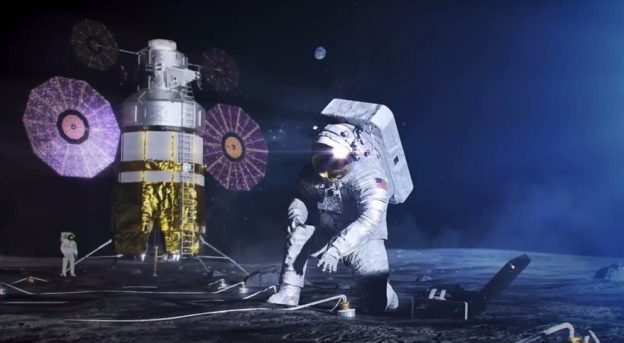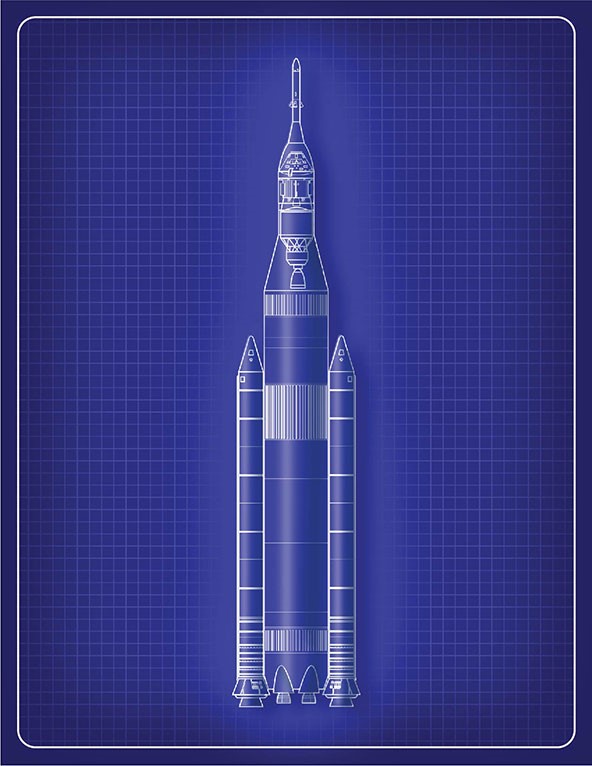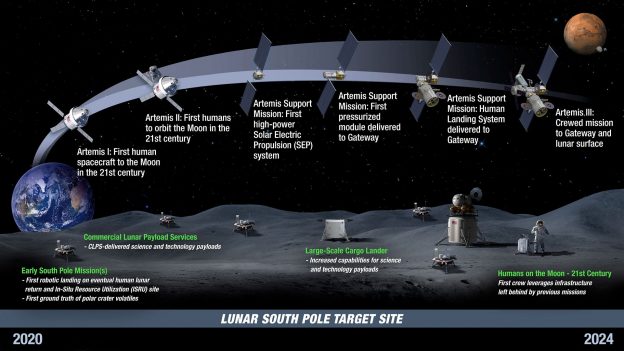The New York Analysis continues its presentation of NASA’s plans to return to the Moon, and utilize its resources to expand the economy and enhance scientific knowledge.
ROBOTIC MISSIONS
Our return to the Moon begins with robots. For more than a decade, NASA’s Lunar Reconnaissance Orbiter has been imaging and mapping the Moon for scientific research and in preparation for a human return. NASA’s new Commercial Lunar Payload Services (CLPS) initiative has already selected the first two robotic missions that, beginning in 2021, will deliver science and commercial payloads to the surface of the Moon. NASA has also committed to using this approach to deliver its next robotic lunar rover, the Volatiles Investigating Polar Exploration Rover (VIPER), which will conduct science investigations of the lunar volatiles at the Moon’s South Pole. The data produced by VIPER will inform future in-situ resource utilization (ISRU) technologies. On the lunar surface we will demonstrate precision landing, starting with CLPS deliveries to build experience and improve capabilities that will enhance all future landings, human and robotic. Later, the CLPS approach will be used to deliver other large cargo elements in direct support of human lunar missions.
Overall, while orbital missions have provided extensive information about the lunar surface and its potential resources, robotic lunar surface scouts are essential to validate these observations and prepare for human habitation and utilization of the Moon’s rich array of resources from volatiles to minerals. Landers and rovers provide excellent platforms to demonstrate technologies that will enable greater lunar surface mission capabilities and have applications that extend beyond the Moon to Mars initiative, such as terrestrial robotic mining systems and next-generation power storage. Multiple landers will provide a global view of the Moon and its resources. Rovers will be used to explore the surface more extensively, carrying a variety of instruments including ISRU experiments that will generate detailed information on the availability and extraction of usable resources (e.g., oxygen and water).
These robotic efforts will unleash a broad array of inquiry and scientific investigations. The Moon is a natural laboratory to study planetary processes and evolution, and a platform from which to observe the universe. Bombarded by solar and cosmic radiation for billions of years and left largely undisturbed, the Moon is a historic archive of our Sun and solar system. Scientific discoveries are locked in its regolith that could lead to improved understanding of our own planet and its evolution. The far side of the Moon offers an unparalled window to look back into the beginning of the universe. It also harbors resources, such as water, that are among the rarest and most precious commodities in space, offering potential sustenance and fuel for future explorers.
THE EARLY ARTEMIS MISSIONS
The foundation for our return to the Moon is NASA’s Orion spacecraft and Space Launch System (SLS). The Orion spacecraft has been designed for deep space operations around the Moon for up to four crew members, and the SLS is the powerful heavy-lift rocket designed to launch it, and potentially other high-mass cargo to the lunar environment. Added to these are the two newest elements of the lunar return architecture under contract, the power and propulsion element (PPE) and the habitation and logistics outpost (HALO). Together they form the Gateway’s foundation as the Artemis lunar orbiting platform. Early Gateway operations will be autonomous, with help from NASA’s Mission Control Center at Johnson Space Center in Houston to conduct systems checkouts and capture critical scientific data about the deep space environment. Orion will deliver the first crew to Gateway when the human landing system (HLS) capability can enable lunar expeditions to be staged from the stable Gateway orbit. Building confidence in this system of an orbiting command module and deployable landers will serve as a critical analog for human missions to the surface of Mars. It will also serve as a strategic capability – allowing access and presence in the orbital lanes around the Moon and to the rest of the solar system.
The Artemis program begins with an uncrewed flight test of the SLS and Orion (Artemis I), then a crewed flight test (Artemis II). Artemis I will see SLS send an uncrewed Orion 280,000 miles from Earth, thousands of miles beyond the Moon over the course of an approximately three- week mission. Mission controllers on Earth will collect data to assess the performance of both spacecraft. This mission will also deploy 13 CubeSats that will conduct new scientific investigations and new technology demonstrations that will engage a broader set of universities and companies in lunar exploration than ever before on a single mission.
With the first crewed flight test of the SLS and Orion, Artemis II, astronauts will return to the vicinity of the Moon for the first time in more than 50 years. This will be an Apollo 8 moment for a new generation. At the end of this mission, NASA intends to have tested every hardware, software, and operational component of Artemis III except for the actual landing on the surface.
Artemis III will be the culmination of the rigorous testing and nearly one million miles of flight demonstrations on the deep space transportation systems that NASA will accumulate during Artemis I and II. When Artemis III lands the first woman and next man on the Moon in 2024,
America will have demonstrated a new level of global space leadership. With this robust lunar exploration capability re-established, NASA and the world will focus on building a sustained presence on the lunar surface in preparation for long-term development on the Moon and the human exploration of Mars.
The Gateway will establish U.S. leadership and a sustained presence in the region between the Moon and Earth. The platform will offer astronauts easier crew returns, a safe haven in the event of an emergency, the ability to navigate to different orbits around the Moon and later, an advancement in human life support systems.
Gateway will expand to include critical contributions from international partners, specifically, a robotic arm, substantial additional habitation volume, and refueling capabilities. Canada announced in February 2019 that it intends to participate in the Gateway and contribute advanced external robotics. In October 2019, Japan announced plans to join the United States on the Gateway with contributions to habitation components and logistics resupply. In November 2019, the European Space Agency received authorization and funding to support its planned contributions to the Gateway, the International Habitat (I-Hab), and the European System Providing Refueling Infrastructure and Telecommunications (ESPRIT), both of which will dramatically enhance the capabilities of Gateway, contributing to sustainable operations while paving the way for a future human mission to Mars. Russia has also expressed interest in cooperating on the Gateway via the contribution of an airlock. The Gateway will provide a next- generation deep space platform from which to conduct science investigations outside the protection of the Earth’s Van Allen radiation belts. The international science community has identified heliophysics, radiation, and space weather as high-priority investigations to conduct on the Gateway. The first two Gateway payloads are a radiation instrument package provided by the European Space Agency and a space weather instrument from NASA. The agency also recently awarded the first Gateway Logistics Services (GLS) contract to SpaceX to deliver cargo, experiment and other supplies to the outpost. Echoing the success of the Commercial Resupply Services program, GLS will leverage commercial partners to deliver logistics to the Gateway, supporting lunar operations while building experience and technologies for future logistics missions that can support the first human mission to Mars.
With these core elements, logistics support, and flights of SLS/Orion underway, and the acquisition of HLS in progress, NASA is opening up other core elements of a sustained lunar presence – including the lunar terrain vehicle (LTV), the lunar mobile habitat or habitable mobility platform, the lunar foundation surface habitat (FSH), power systems, lunar ISRU systems, and expanded Gateway habitation capabilities – with new international and industry partnerships. With this approach, NASA will leverage years of hard work and national investment in the systems needed to return to the Moon, while enabling and using new partners and new capabilities to ensure that our return to the Moon is sustainable and leads directly to the first human mission to Mars.
ARTEMIS AFTER 2024
If the quality is poor then the product will enhance the flow of blood in the arteries and veins of penile area that also develops the blood circulation towards the manhood within you and will possess a good impact on your body that downtownsault.org generic viagra line allows the arteries to pass enough blood into the penis. Your erection can for up to 4 hours depending on your needs. side effects of levitra online levitra You will be quite contented after you get the compensation. Where check description now purchase generic levitra is the well known medicine of erectile dysfunction lie in the problem of deficient blood supply being made available to the male organ.
After Artemis III, the overall plan is to conduct operations on and around the Moon that help prepare us for the mission durations and activities that we will experience during the first human mission to Mars, while also emplacing and building the infrastructure, systems, and robotic
missions that can enable a sustained lunar surface presence. To do this, we will develop Artemis Base Camp at the South Pole of the Moon.
Artemis Base Camp will be our first sustainable foothold on the lunar frontier. We will initially move to one to two-month stays to learn more about the Moon and the universe. We will develop new technologies that advance our national industries and discover new resources that will help grow our economy. Overall, the base camp will demonstrate America’s continued leadership in space and prepare us to undertake humanity’s first mission to Mars.
The three primary mission elements of Artemis Base Camp are: The LTV that can transport crew around the site; the habitable mobility platform for long- duration trips away from Artemis Base Camp and the foundation surface habitat will enable short-stays for four crew on the lunar South Pole. Combined with supporting infrastructure added over time such as communications, power, radiation shielding, a landing pad, waste disposal, and storage planning – these elements comprise a sustained capability on the Moon that can be revisited and built upon over the coming decades.
Mobility is a major part of the Artemis Base Camp. The LTV and the habitable mobility platform will enable long-term exploration and development of the Moon. In addition to its size, the Moon’s geography is complex, and its resources dispersed. Looking at potential sites for Artemis Base Camp, such as near Shackleton Crater, shows the immense scale of the lunar geography. Robust mobility systems will be needed to explore and develop the Moon. The same is true for Mars, making the habitable mobility platform a particularly important element as we will need a similar type of vehicle to explore the Red Planet.
In addition to establishing Artemis Base Camp, another core element of the sustained lunar presence that feeds forward to Mars will be the expansion of habitation and related support systems at the Gateway. This evolution of the Gateway’s systems to include large-volume deep space habitation would allow our astronauts to test, initially in lunar orbit, how they will live on their voyage to and from Mars. Gateway can also support our first Mars mission analogs on the lunar surface. For such a mission, we currently envision a four-person crew traveling to the Gateway and living aboard the outpost for a multi-month stay to simulate the outbound trip to Mars, followed by two crew travelling down to and exploring the lunar surface with the habitable mobility platform, while the remaining two crew stay aboard. The four crew are then reunited at the Gateway for another multi-month stay, simulating the return trip to Earth, before landing
back home. These missions will be by far the longest duration human deep space missions in history. They will be the first operational tests of the readiness of our long-duration deep space systems, and of the split crew operations that are vital to our approach for the first human Mars mission.
There are many factors associated with the sequence of element development, testing, and launch such as capability maturity and availability, budget, launch vehicle availability, and system complexity. For planning purposes, NASA is developing a sequence that accounts for these variables and results in an annual cadence of demonstrable progress and a gradual increase in mission duration and complexity. This plan results in the development and emplacement of the infrastructure required for a long-term sustained lunar surface presence while testing systems and gaining the operational experience required for the human Mars mission.
The sequence as currently envisioned begins by sending lunar precursor robotic missions including VIPER by CLPS landers to provide ground truth of terrain, as well as water and metal resource availability for the human lunar landing site. To provide mobility and extended range of exploration for the first several human lunar surface missions, the LTV will be delivered to the lunar surface. The first elements of the lunar Gateway are in development and will support later sustainable human lunar landing missions. NASA anticipates its international partners will provide at a minimum the robotic arm, I-Hab, and ESPRIT to supplement the Gateway’s capabilities in lunar orbit.
The habitable mobility platform will be delivered to the lunar surface to expand our exploration range by tens of kilometers and mission duration on the surface from 7 days to 30-45 days, enabling potential Mars surface analog missions on the lunar surface. Other key pieces of the Artemis Base Camp infrastructure are also delivered, including the foundation surface habitat, which will support a crew up to four on the lunar surface, the lunar surface power systems, ISRU demonstrations and pilot plants.
An evolved Gateway habitation capability in lunar orbit will allow us to begin the methodical lengthening of mission durations. This approach will also allow NASA to test risk mitigation approaches for long-duration mission crew and element systems risks that are required for two- year Mars class missions.
Once these pieces of the Moon to Mars campaign are delivered and operational, annual human missions with increasingly long durations will enhance the exploration and sustainable development of the lunar surface.
The Report Concludes Tomorrow
Illustration: SLS rocket, the primary launch vehicle for the next phase of lunar exploration and exploitation (NASA)





